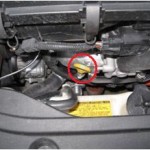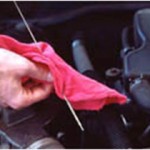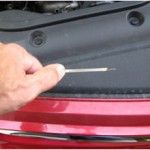Why?
Oil lubricates your engine’s moving parts and minimizes friction. Keeping your oil clean and at its appropriate level will not only increases fuel efficiency, but reduces emissions too. A low oil level will result in increased engine friction and wear on the moving parts. Your engine will have to work harder to overcome the increased friction and will use more fuel.
Changing the engine oil and filter according to manufacturer’s recommendations is a simple way to keep your vehicle running well and extend its engine’s life. It removes dirt and other impurities that can cause wear and tear on your engine. Engine oil loses it’s viscosity over time and thickens. This reduces its ability to flow and thus reduces its ability to lubricate. This increased friction will result in increased fuel consumption and wear.
Using the manufacturer’s recommended grade of oil will improve starting and increase fuel efficiency especially in winter. Remember that if you change your own oil, take the used oil to your local service station so that it can be recycled. Just 1 litre of oil can contaminate 2 million litres of water!
Want to know more about oil viscosity and grades, click here.
When?
Check your oil level regularly and before leaving on longer trips. Change your oil in accordance with your car manufacturer’s recommendations. It is also a good idea to check regularly under your car for any fluid leaks and have them dealt with right away.
How do I do this?
- Make sure your car is parked on level ground and in a well lit area.
- Make sure that your car has been shut off for at least a few minutes and the oil has had a chance to settle before checking.
- Open the front hood. The release for the hood can either be inside the car, usually located under the steering wheel or outside located in or under the grill area. If you are unfamiliar with opening the hood, the next time you fill up with gas, ask the attendant to check the oil and watch or ask questions as it is being done. The next time you can do it yourself.
-

Photo: Green Action Centre
With the hood open, find the dipstick. It is a long rod that goes down into the engine to check the level of the oil. The handle is usually brightly colored (yellow/orange) and often will have “OIL” written on it.
-

Photo: Green Action Centre
Pull the dipstick out while holding a rag around the dipstick in the area where it is being removed from. This will wipe off the oil as it is being removed and avoid dripping oil on your engine.
- Re-insert the dipstick all the way down into the tube where it was removed from and remove it again, this time without wiping it off. Holding the dipstick horizonally you can see the level of the oil and check it against the indicators on the dipstick.

Photo: Green Action Centre
- If the level is close to the upper mark, you are done. If it is closer to or below the lower mark, you need to add oil. Usually the difference between the lower and upper mark is approximately a liter of oil.
- If you need to add, make sure that you consult your owner’s manual so that you know the right type (viscosity) of oil to use.
- Look for the cap on top of your engine that says “OIL” and remove it.
- Using a funnel, carefully pour in some oil, wait a minute or so, and check the level again. You need to be careful not to overfill the oil and so it is best to add smaller amounts and check as you go. With experience you will get a better idea of how much is needed.
Want to see a video on checking your oil? Click here!
- If the level is close to the upper mark, you are done. If it is closer to or below the lower mark, you need to add oil. Usually the difference between the lower and upper mark is approximately a liter of oil.
- If you need to add, make sure that you consult your owner’s manual so that you know the right type (viscosity) of oil to use.
- Look for the cap on top of your engine that says “OIL” and remove it.
- Using a funnel, carefully pour in some oil, wait a minute or so, and check the level again. You need to be careful not to overfill the oil and so it is best to add smaller amounts and check as you go. With experience you will get a better idea of how much is needed.



Recent Comments